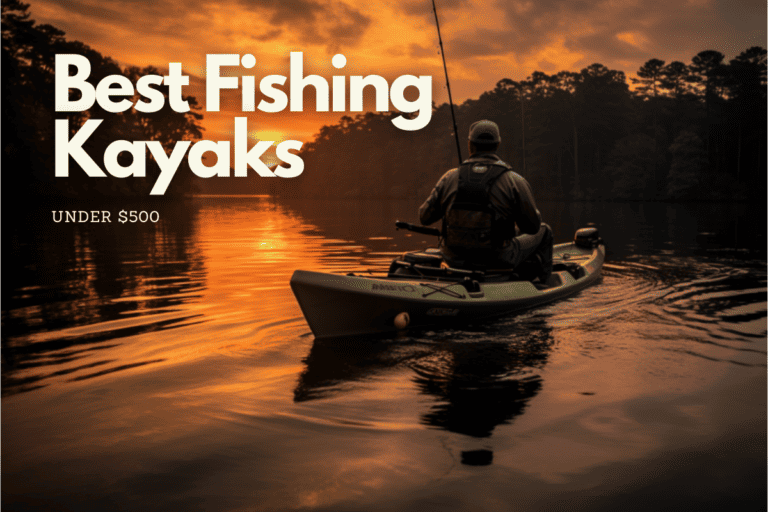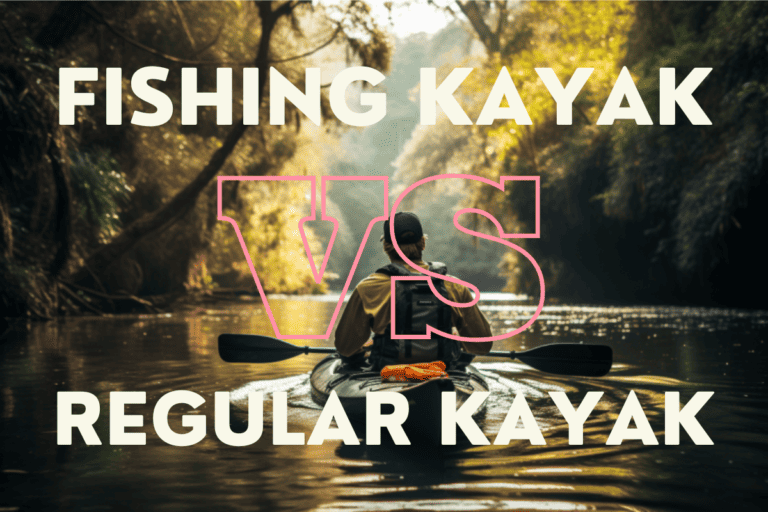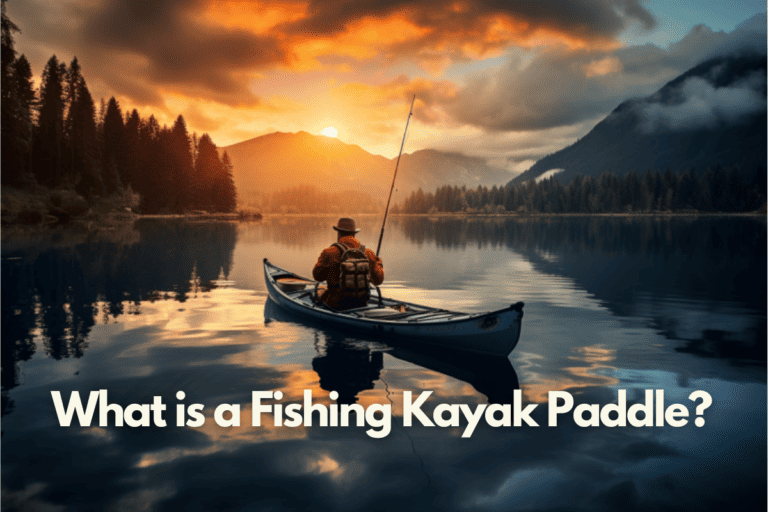Is Kayak Fishing Safe? (The 8 Ways it Can Be Dangerous)
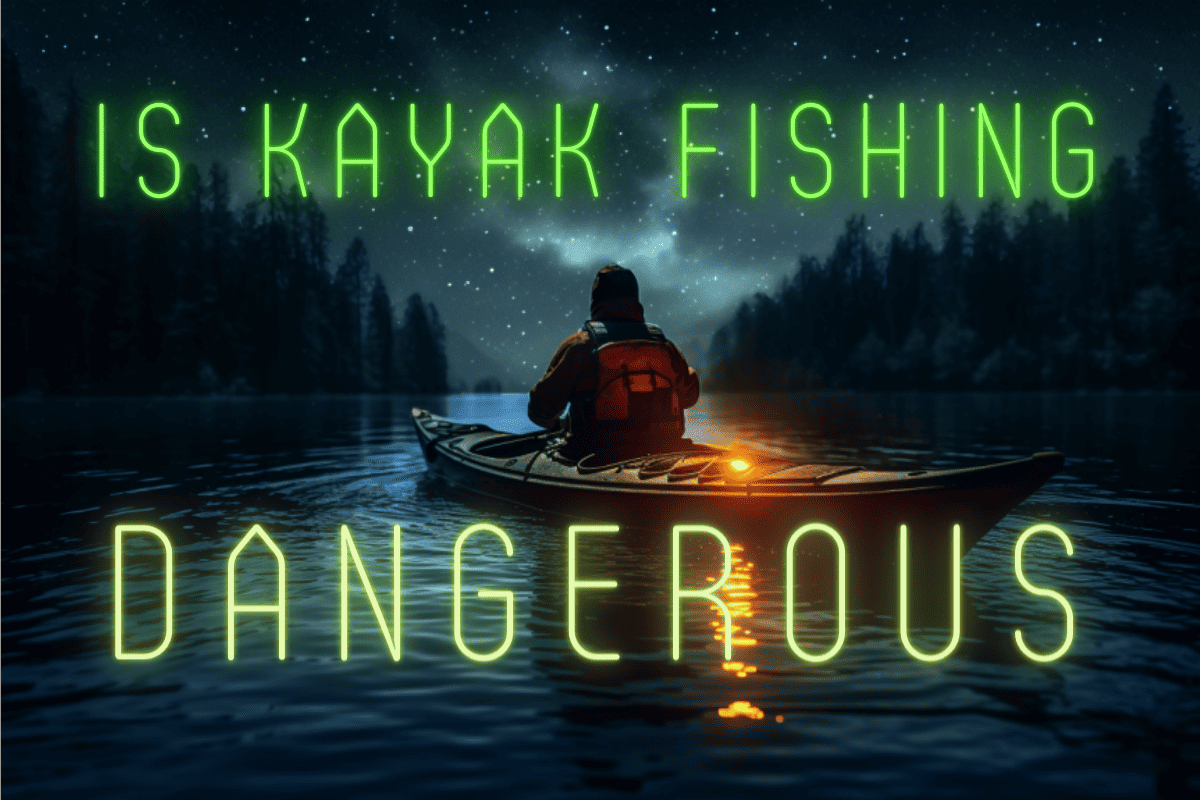
You’re ready to cast your line into the world of kayak fishing. But wait! Is it safe? You’re not Captain Ahab chasing a whale; you’re just looking for a peaceful catch.
As you navigate the waters of this exciting sport, let’s dive into the potential risks, from capsizing to wildlife encounters, and how you can be prepared.
Welcome to the group, let’s ensure your kayak fishing adventures are safe and enjoyable.
Is Kayak Fishing Safe?
You’re probably wondering, is kayak fishing safe? Well, it’s as safe as you make it. Like any activity, there’s a risk factor, and yes, kayak fishing can be dangerous. But don’t let that deter you – with proper precautions, it can also be a safe, fulfilling hobby.
The key to safe kayak fishing is preparation. Being a well-prepared kayak angler means being aware of your environment, understanding the potential risks, and taking the necessary measures to mitigate them. It’s about respecting nature and understanding that the water can be unpredictable.
Remember, every kayak fishing experience is different. What might be a breeze for one person can be a challenge for another. But don’t let that intimidate you. By following the safety guidelines at the end of this article, you can enjoy an unforgettable day on the water.
Top 8 Ways Kayak Fishing Can Be Dangerous
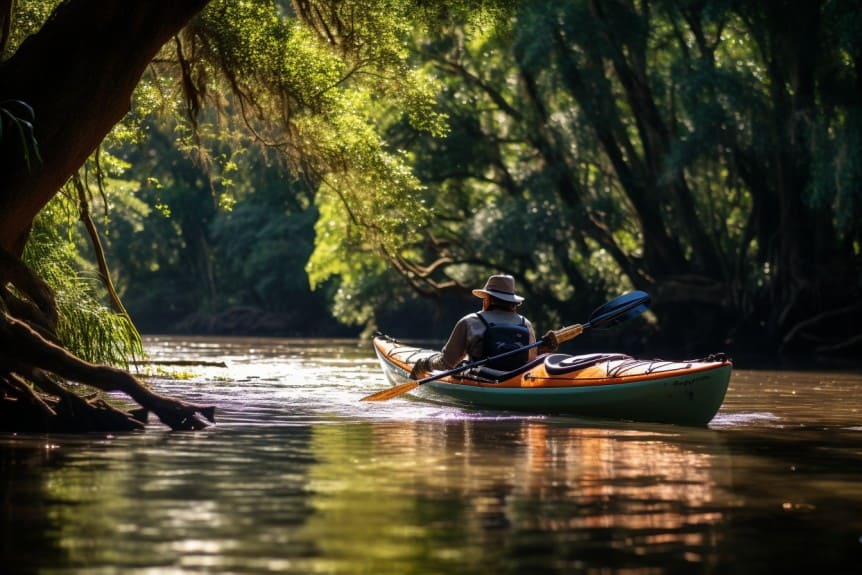
Below are the top 8 ways kayak fishing can be dangerous. After this list, we offer safety advice on how to make it as safe as possible.
1. Understanding the Risks of Capsizing and Drowning
It’s crucial to understand the risks of capsizing and drowning when you’re out on the water. Kayaking isn’t just about the thrill and adventure. It’s about being part of a community that respects the power of nature and prioritizes safety. Regardless of your expertise, capsizing is always a possibility.
Currents, wind, or even the excitement of a large catch can tip your kayak.
Now, you’re not alone in this. We’re all in the same boat, or, more accurately, the same kayak. We all wear our personal flotation devices (PFDs), not just because it’s smart, but because we value our lives and the people waiting for us onshore. A PFD isn’t a sign of inexperience; it’s a badge of a responsible kayaker.
Practice makes perfect, and self-rescue techniques are no exception. They’re not just for emergencies, they’re for peace of mind. Securing your equipment to your kayak doesn’t just protect your investment, it keeps you from being a hazard to others.
2. The Danger of Getting Lost and Navigational Tips
Navigating open water can be tricky, so don’t underestimate the importance of planning your route and identifying landmarks. You’re part of a community that values safety and preparation, so remember, kayak fishing can be dangerous if you’re not careful. Don’t get caught up in the excitement of reaching a new fishing spot without considering your return.
Consider this: You’ve spent hours fishing at night, your cooler is full, but suddenly, everything looks the same in the moonlight. Don’t panic, you’ve got this. Your chosen landmarks can guide you back. Maybe it’s a uniquely shaped tree on the shoreline, or a distinctive rock formation. These natural beacons are your allies, guiding you home safely.
Use your navigation devices wisely. Keep them charged and within reach. They’re your lifelines when landmarks are scarce. And always keep someone informed about your route. We’re all in this together, friend. Your safety is our safety.
3. Equipment Failures: From Kayaks to Fishing Gear
Let’s delve into the topic of equipment failures, from vessels to angling gear, and discuss how proper planning can keep you afloat when things go wrong.
As a kayak angler, you’re part of a community that values both the thrill of the catch and the tranquility of the water. That balance can quickly tip, however, when equipment failures disrupt your trip.
Imagine you’re out on the water, ready to kayak fish, when a leak in your kayak or a break in your paddle occurs. That’s when your preparation and backup plan come into play, keeping your kayak fishing safe. By regularly inspecting and maintaining your fishing gear, you reduce the chance of unexpected mishaps.
But what if something does go wrong? That’s where your repair kits, spare paddles, and backup fishing gear prove their worth. They’re not just equipment, they’re your lifelines, your assurance that you can handle whatever comes your way.
Being prepared for equipment failures isn’t just about safety, it’s about belonging. It’s about respecting the community values of kayak angling and showing that you’re ready to uphold them, no matter what.
4. Wildlife Encounters: From Sharks to Insects
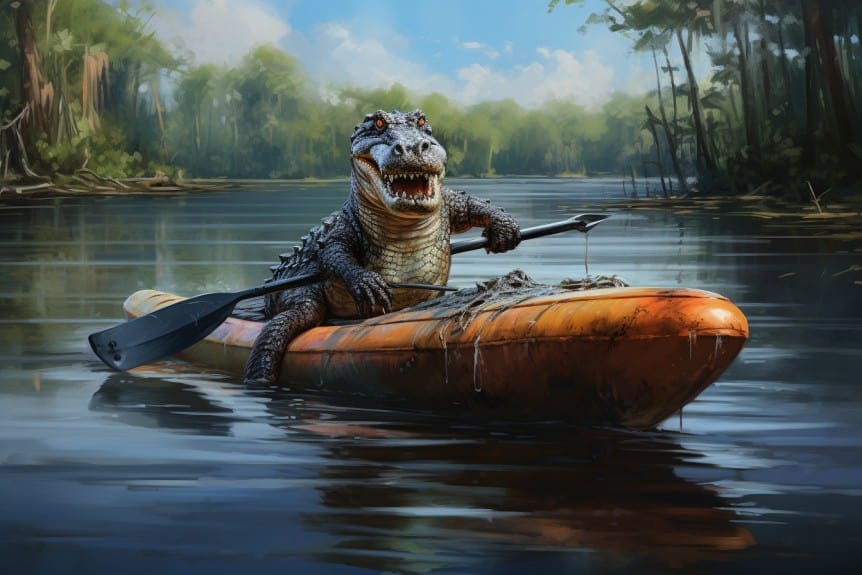
You’re out there in the midst of nature, and chances are you’ll encounter wildlife ranging from snakes to insects, so understanding their behaviors is crucial.
It’s not about fearing these creatures, but about respecting their space and knowing how to react should you cross paths. For instance, if an alligator approaches, keep your paddle between you and it, maintaining as much distance as possible. If a shark comes too close, avoid splashing as it could be mistaken for prey. And don’t forget about the smaller foes, like insects. Repellents can be a lifesaver.
5. Navigating Challenges: Large Boats, Waves, and Currents
Dealing with larger boats, waves, and currents can be tough when you’re out on the water. As a kayak fisherman, these situations can pose dangerous situations that require rapid thinking. Yet, don’t let these challenges deter you. They’re part of the journey, and with proper knowledge and practice, you can navigate them safely.
Understanding larger vessels’ paths and the waves they generate is key. These waves can destabilize your kayak, but knowing how to ride them will keep you safe. Remember, you’re not alone in this. We’re all navigating these challenges together.
Natural currents and sea waves present another test. They can be unpredictable, but with familiarity of the water body and practice in controlled environments, you can conquer them. It’s about becoming one with the water, understanding its rhythms and patterns.
Visibility is also crucial. Make sure you’re seen by larger vessels to avoid collisions. This is one way we look out for each other in this big, wide, water world.
Remember— you’re a kayak fisherman. You’ve got the strength, the courage, and the community to face these challenges. Let’s navigate these large boats, waves, and currents together, keeping each other safe and enjoying the journey.
6. Weather Challenges: From Extreme Heat to Sudden Storms
Weather challenges, from extreme heat to sudden storms, pose another set of hurdles, but they’re not insurmountable with proper preparation and awareness. On your kayak fishing trip, it’s crucial to keep an eye on the weather forecast. Know that you’re not alone in this; we’re all keeping each other safe out there.
Extreme heat can be a risk. Dehydration and heat stroke are serious weather-related injuries that can spoil your trip. So, it’s essential to bring plenty of water and wear clothes that protect you from the sun. Feeling the sun on your skin is part of the joy of kayak fishing, but it’s worth sacrificing a bit of that joy to ensure a safe trip.
Sudden storms can whip up in no time, turning calm waters into a hazardous playground. If you see dark clouds on the horizon, it’s better to cut your trip short. Remember, the fish will still be there another day, and so should you.
We’re all in this together, looking out for each other, sharing information, and ensuring everyone has a safe and enjoyable time on the water.
7. Physical Strain and Exhaustion in Kayak Fishing
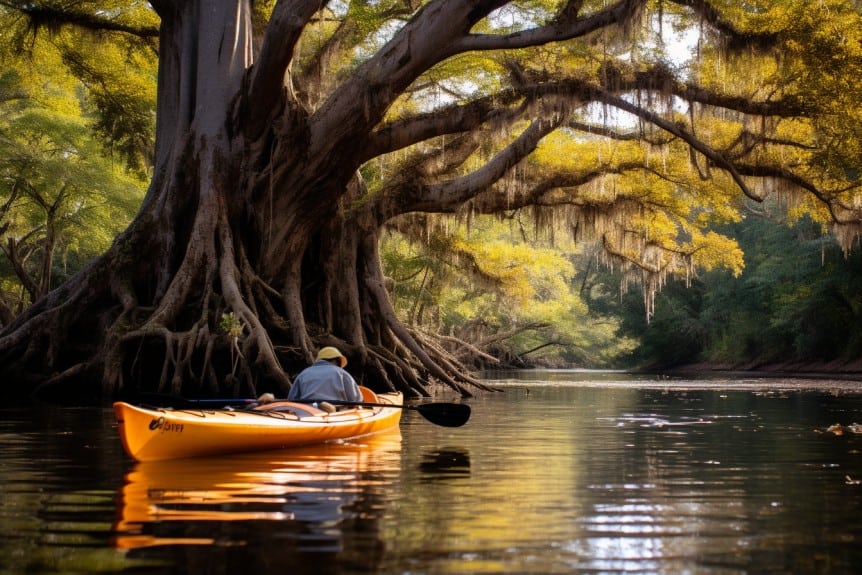
It’s crucial to recognize when your body’s tiring out on the water, as pushing yourself too hard can lead to exhaustion. Kayak fishing, while a thrilling adventure, can be physically challenging. The act of paddling, particularly against the wind or currents, coupled with the effort of fishing can exert significant physical strain and risk of exhaustion.
But don’t let this dissuade you. Kayak fishing remains a relatively safe and enjoyable sport if you listen to your body and respect your limits. Begin in calm waters, gradually upping the challenge as your strength and stamina increase. Breaks are your friend; don’t hesitate to take them as often as you need.
Dehydration is another potential hazard. The excitement and focus on the catch can easily make you forget to hydrate. So, let this be a reminder to drink water regularly.
In the end, you’re not just a kayaker, but part of a wider community that respects the water and looks out for each other. Remember, the goal is not just about the catch, but about enjoying the experience, the camaraderie, and the great outdoors.
8. Environmental and River Obstacles: Rapids, Rocks, and More
As a fisherman, you’re no stranger to the unexpected, but the body of water you’re navigating may have more in store than you bargained for. Kayak anglers, in particular, face unique hurdles when going kayak fishing.
River obstacles are not just environmental, they include man-made structures like dams too. These challenges can be dangerous, leading to capsizing or even damage to your equipment. But don’t let these potential pitfalls deter you from the thrill of kayak fishing.
Researching the chosen body of water is a key step to ensure your safety. Understand the possible environmental and river obstacles you might face. Practice navigation techniques to steer yourself clear of trouble. And remember, should you face a sudden challenge, stay calm. Rely on your practiced skills to navigate through.
In this community of kayak anglers, you’re not alone. We’ve all been there, navigating the unexpected. So, let’s share our collective wisdom and ensure every adventure out on the water remains a safe one.
Our Top Safety Tips for Kayaking
Kayaking offers a unique way to explore nature; however, it’s essential to prioritize safety to ensure a pleasant experience. Here are some safety guidelines sourced from the U.S. National Park Service:
- Type of Kayak: Ensure you have the right kind of kayak for the environment. Sea kayaks, which are long and slim, are the only ones recommended for vast waters like Lake Superior. These kayaks have bulkheads to prevent water from flooding the entire boat. On the other hand, recreational or general-purpose kayaks are best suited for calm rivers, ponds, or small lakes. Canoes, being open and wider, can be challenging to control in windy conditions and are not recommended for large open waters like Lake Superior.
- Essential Equipment: Before setting out, make sure you have the required life jacket and whistle. Life jackets are crucial for safety, and a whistle can be used to signal for help if needed.
- Weather Check: Always check the marine weather forecast before heading out. Weather conditions can change rapidly, especially in areas near cliffs or open waters. Websites like www.greatlakesbuoys.org provide real-time data and video from buoy cams to help you assess conditions.
- Self-Rescue Skills: It’s vital to know how to perform a self-rescue. This means being able to get back into your kayak if you capsize. Regular practice is essential to ensure you can execute these skills under pressure.
- Communication: Cell phone coverage can be spotty in many kayaking locations. Even if you manage to call for help, rescue might take time. Always inform someone about your kayaking plans, including your route and expected return time. This “float plan” ensures someone knows where to look if you don’t return as scheduled.
- Paddling with Pets: While it might be tempting to bring along your furry friend, kayaking with pets on vast waters like Lake Superior is not recommended. The unpredictable nature of such waters can pose risks to both the paddler and the pet.
- Group Paddling: Whenever possible, paddle with others. Not only does this provide an added layer of safety, but fellow kayakers can also assist with rescues if needed.
- Cold Water Precautions: Cold water can be deadly, even if the weather is warm. Always wear a life jacket, and consider wearing a wetsuit in colder conditions to protect against hypothermia.
While kayaking offers a unique way to connect with nature, safety should always be the top priority. Proper preparation, equipment, and awareness can ensure a safe and enjoyable experience.
Final Thoughts
So, you’ve got a taste of the many risks that lurk beneath the calm surface of kayak fishing. But don’t let that scare you off. It’s all part of the thrill, the dance with danger that makes the catch sweeter.
Stay prepared, stay alert, and kayak fishing will be as safe as a house. After all, every rose has its thorns, right?
Frequently Asked Questions (FAQ)
Q: Is kayak fishing safe?
A: Kayak fishing can be safe if you take the necessary precautions and follow safety guidelines.
Q: What are some beginner kayaking tips for fishing?
A: Some beginner kayaking tips for fishing include staying close to shore, practicing your paddling techniques before venturing out, and wearing a personal flotation device (PFD).
Q: Can kayak fishing be dangerous?
A: Yes, kayak fishing can be dangerous if proper safety measures are not followed or if you find yourself in dangerous situations.
Q: What are some of the dangerous situations to be aware of while kayak fishing?
A: Some dangerous situations to be aware of while kayak fishing include strong winds or currents, rough waters, and sudden weather changes.
Q: Should I wear a personal flotation device (PFD) while kayak fishing?
A: Yes, it is highly recommended to wear a personal flotation device (PFD) while kayak fishing as it can potentially save your life in case of an accident.
Q: What should I do if I flip my kayak while fishing?
A: If you flip your kayak while fishing, remain calm and try to get back on the kayak as quickly as possible. Use your kayak paddle or any nearby floating objects to help you get back onto your kayak.
Q: How can I prevent my kayak from flipping while fishing?
A: To prevent your kayak from flipping while fishing, make sure to distribute your weight evenly, keep the nose of your kayak perpendicular to the waves or currents, and maintain stability by having a low center of gravity.
Q: Is sunscreen necessary while kayak fishing?
A: Yes, it is important to apply sunscreen while kayak fishing to protect your skin from harmful UV rays.
Q: How can I keep my fishing gear secure inside the kayak?
A: To keep your fishing gear secure inside the kayak, use bungee cords or straps to fasten them down. Additionally, consider using waterproof storage containers to keep your gear dry.
Q: Can I fish from any type of kayak?
A: While you can fish from various types of kayaks, it is recommended to use a kayak specifically designed for fishing as it usually provides better stability and storage options for your fishing gear.
